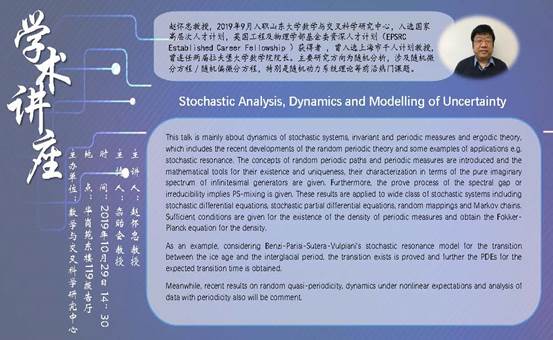Stochastic Analysis, Dynamics and Modelling of Uncertainty

Professor Zhao Huaizhong, joined the Research Center for Mathematics and Interdisciplinary Sciences of Shandong University in September 2019, was selected as the National High-level Talent Program, was awarded the EPSRC Established Career Fellowship by the Ministry of Engineering and Physics, and was selected as the Shanghai Thousand Talents Program Professor, has been re-elected twice as Dean of the School of Mathematics, Loughborough University. The main research direction is stochastic analysis, involving stochastic differential equations/stochastic partial differential equations, especially hot topics such as stochastic dynamic system theory.
This talk is mainly about dynamics of stochastic systems, invariant and periodic measures and ergodic theory, which includes the recent developments of the random periodic theory and some examples of applications e.g. stochastic resonance. The concepts of random periodic paths and periodic measures are introduced and the mathematical tools for their existence and uniqueness, their characterization in terms of the pure imaginary spectrum of infinitesimal generators are given. At the same time the prove process of the spectral gap or irreducibility implies PS-mixing is given. These results apply to wide class of stochastic systems including stochastic differential equations, stochastic partial differential equations, random mappings and Markov chains. We give sufficient conditions for the existence of the density of periodic measures and obtain the Fokker-Planck equation for the density.
As an example, considering Benzi-Parisi-Sutera-Vulpiani’s stochastic resonance model for the transition between the ice age and the interglacial period, we prove the transition exists and further obtain the PDEs for the expected transition time.
Meanwhile, recent results on random quasi-periodicity, dynamics under nonlinear expectations and analysis of data with periodicity also will be comment.
(Editor in Charge: Lei Hao)